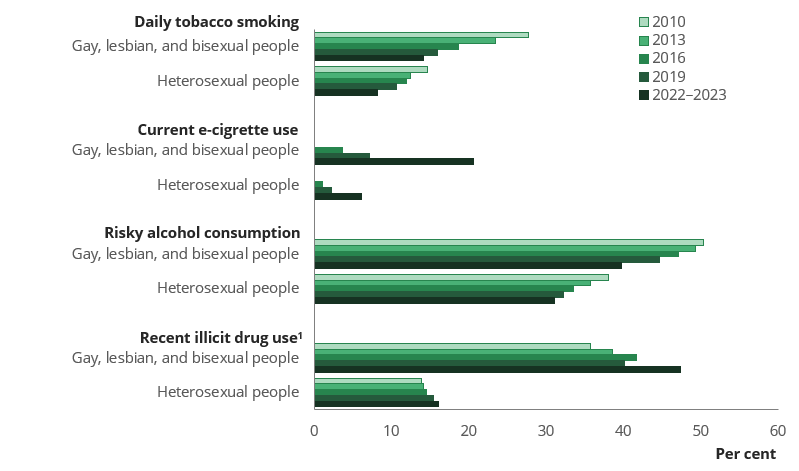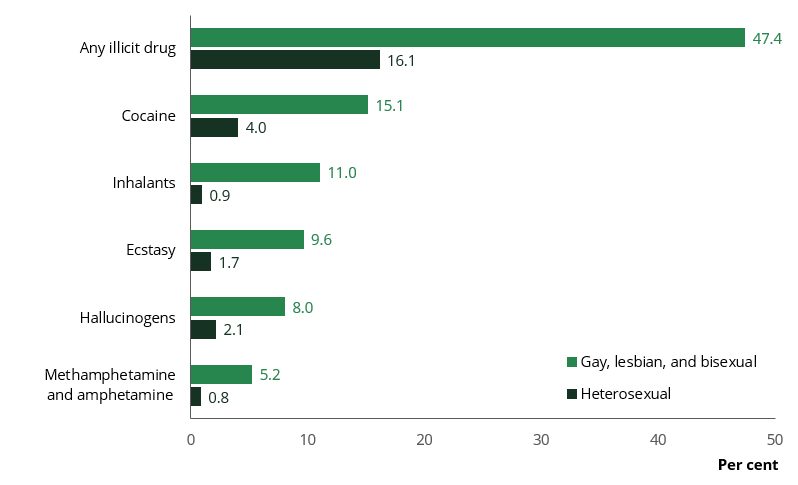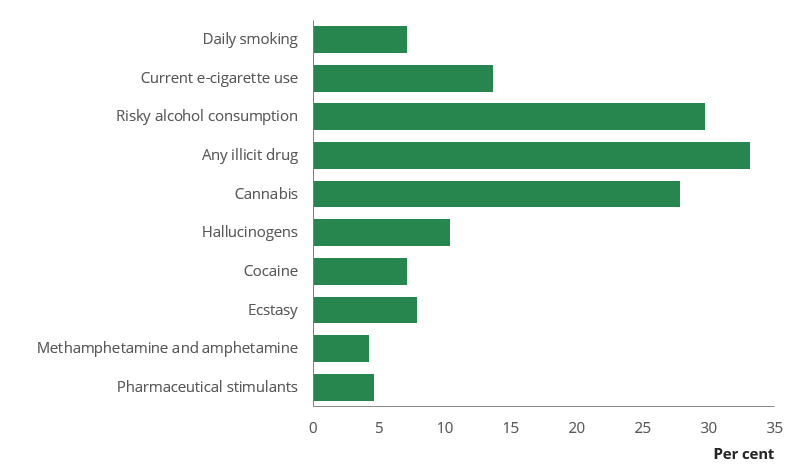LGBT people in the National Drug Strategy Household Survey
Gay, lesbian, bisexual, transgender, and intersex (LGBTI) people can be at an increased risk of alcohol, tobacco and other drug problems (Department of Health and Aged Care 2017). These increased risks may come from many sources, including stigma and discrimination, familial issues, and lack of support.
It is difficult to estimate the number of people in Australia who are lesbian, gay, bisexual, trans or gender diverse, intersex or queer. This is due to a few factors including an absence of questions in population-based surveys around sex, gender and identity and that most studies to date focus on gay, lesbian, and bisexual people (AIHW 2023).
The National Drug Strategy Household Survey (NDSHS) includes questions on gender and sex recorded at birth. These questions allow for the derivation of cisgender and trans and gender diverse variables in the survey. While some jurisdictions include intersex as an option for birth certificates, which may be captured in the ‘Another term’ response option in the sex at birth question, this option cannot be used as a count of people who have variations of sex characteristics (ABS 2020). Results from the 2022–2023 NDSHS cannot be generated for intersex people.
In the 2022–2023 NDSHS sample, 5.1% of people aged 14 and over reported that they were gay, lesbian, or bisexual. The 2022–2023 NDSHS survey was the first to include questions representing people who are transgender or gender diverse, and 0.9% of people aged 14 and over reported that they were trans or gender diverse.
Findings for gay, lesbian, and bisexual people are grouped together for data quality purposes, but it is important to note that there are differences in substance use between each population. Similarly, transgender people and other gender diverse people are grouped together for data quality purposes.
Daily smoking among gay, lesbian and bisexual people continued to decline
The daily tobacco smoking rate among gay, lesbian and bisexual people has been on a long-term decline, from 28% in 2010 to 14.2% in 2022–2023. Over the same period, the daily smoking rate also declined among heterosexual people (Figure 1). In 2022–2023 gay, lesbian, and bisexual people were 2.0 times as likely as heterosexual people to smoke daily (after adjusting for differences in age), up from 1.5 times as likely in 2019.

1. Used any illicit drug in the previous 12 months.
Source: NDSHS 2022–2023, Table 10.5.
Use of vapes and e‑cigarettes among gay, lesbian, and bisexual people more than doubled
In 2022–2023, more than 1 in 5 (21%) gay, lesbian and bisexual people reported currently using electronic cigarettes and vapes ('e–cigarettes'). This was almost triple the proportion that were doing so in 2019 (7.1%), and almost 1 in 2 gay, lesbian, and bisexual people had used e‑cigarettes at some point in their lifetime (46%).
There was also a substantial increase in the proportion of gay, lesbian, and bisexual people who both smoked and used e‑cigarettes, from 3.8% in 2019 to 7.8% in 2022–2023.
Even though the use of e‑cigarettes also sharply increased among heterosexual people, they were much less likely than gay, lesbian, and bisexual people to currently use them in 2022–2023 (Figure 1). After adjusting for differences in age, gay, lesbian, and bisexual people were 2.1 times as likely as heterosexual people to currently use e‑cigarettes.
Around 2 in 3 (68%) gay, lesbian, and bisexual people neither smoked nor vaped in 2022–2023, substantially lower than the 86% of heterosexual people who did neither.
Long term declines in risky drinking among gay, lesbian and bisexual people continued
Between 2010 and 2022–2023, the proportion of gay, lesbian and bisexual people drinking alcohol at risky levels (which includes drinking more than 10 standard drinks per week on average or more than 4 standard drinks in a single day at least monthly) declined from 50% to 40%. These declines were driven by both a reduction in the proportion drinking more than 10 standard drinks per week (from 39% in 2010 to 28% in 2022–2023) and a similar reduction in the proportion drinking more than 4 standard drinks in a single day at least monthly (from 45% to 36%).
A similar long-term reduction occurred among heterosexual people (Figure 1). While gay, lesbian, and bisexual people remain more likely to consume alcohol at risky levels than heterosexual people, after adjusting for differences in age, gay, lesbian, and bisexual people were 1.2 times as likely as heterosexual people to consume alcohol at risky levels. This was smaller than the gap in 2019 (1.4 times as likely) but similar to 2010, when gay, lesbian, and bisexual people were also 1.2 times as likely as heterosexual people to consume alcohol at risky levels.
Increases in illicit drug use among gay, lesbian, and bisexual people
In 2022–2023, almost 1 in 2 (47%) gay, lesbian or bisexual people had used an illicit drug in the previous 12 months, representing a substantial increase since 2019 when 40% had done so. This was largely driven by two factors, although small increases occurred across most illicit drugs:
- The proportion who had used cocaine in the previous 12 months increased from 10.5% in 2019 to 15.1% in 2022–2023.
- The proportion who had used a pharmaceutical stimulant (such as Ritalin or methylphenidate) for non‑medical purposes in the previous 12 months (6.2%). This was a new drug category introduced in 2022–2023.

Source: NDSHS 2022–2023, Table 10.5.
After adjusting for differences in age, gay, lesbian, and bisexual people were 2.4 times as likely as heterosexual people to have used any illicit drug in the previous 12 months. This higher rate of overall use was evident in almost all individual illicit drugs reported (Figure 2).
Some illicit drugs showed larger differences between the two groups. Compared with heterosexual people, gay, lesbian and bisexual people were (after adjusting for differences in age):
- 8.6 times as likely to have used inhalants in the previous 12 months. This is likely due to the use of nitrites during sexual activity by men who have sex with men (Vaccher et al. 2020), although use was high among all gay, lesbian, and bisexual people in the survey.
- 6.6 times as likely to have used methamphetamine and amphetamine in the previous 12 months.
- 3.4 times as likely to have used ecstasy in the previous 12 months.
- 2.7 times as likely to have used cocaine in the previous 12 months.
While cannabis and cocaine were the most commonly used illicit drugs among both population groups, the other commonly used illicit drugs were different in 2022–2023 (Table 1).
Gay, lesbian, and bisexual people | Heterosexual people |
|---|
Cannabis (33%) | Cannabis (10.4%) |
Cocaine (15.1%) | Cocaine (4.0%) |
Inhalants (11.0%) | Hallucinogens (2.1%) |
Ecstasy (9.6%) | Pain-killers/pain-relievers and opioids1 (2.0%) |
Hallucinogens (8.0%) | Ecstasy (1.7%) |
1. Used for non‑medical purposes.
Note: Results are presented as standard percentages. For comparisons, age standardised results can be found in the supplementary data tables.
Source: NDSHS 2022–2023, Table 10.5.
Tobacco, alcohol, and illicit drug use among trans and gender diverse people
As the 2022–2023 NDSHS survey was the first to include questions representing people who are transgender and gender diverse, it is not possible to make comparisons to previous years. The sample size for trans and gender diverse people was small in 2022–2023, so these results should be considered as an indicative snapshot of alcohol and other drug use, rather than a representative picture of drug use by gender experience.

Source: NDSHS 2022–2023, Table 10.7.
Use of tobacco, e‑cigarettes and alcohol among trans and gender diverse people (Figure 3) reflected use in the general population:
- In 2022-2023, *7.1% of trans and gender diverse people smoked tobacco daily.
- Almost 1 in 3 (30%) consumed alcohol in ways that put their health at risk
(similar to the proportion of cisgender people, 31%). However, trans and gender diverse people were 1.3 times as likely as cisgender people to drink more than 4 standard drinks in a single day at least once a month (after adjusting for differences in age).
- While the proportion of trans and gender diverse people who currently used e‑cigarettes was high in 2022–2023 (nationally, only 7.0% of people currently used e‑cigarettes in 2022–2023), this was largely because they tended to be younger than the cisgender population surveyed in the NDSHS, and younger people were much more likely to use e‑cigarettes. After adjusting for differences in age, trans and gender diverse people were equally as likely as cisgender people to currently use e‑cigarettes in 2022–2023.
* Estimate has a relative standard error between 25% and 50% and should be interpreted with caution.
One in 3 trans and gender diverse people (33%) had used an illicit drug in the previous 12 months. After adjusting for differences in age, compared to cisgender people, trans and gender diverse people were 1.6 times as likely to have used any illicit drug in the previous 12 months.


